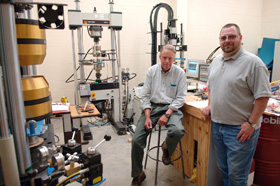The new report from Sandia National Laboratories, called "MSU/DOE Fatigue
Database for Composite Materials" shares data from 17 years of accumulated
10,000 results on about 150 different composite materials. It is compiled
by John Mandell, Dan Samborsky and students at Montana State University (MSU).
According to the government laboratory, the database is one of the world's
largest open-access libraries on wind turbine materials, the largest in
the U.S. Most importantly, the data is being made available to the public.
Wind turbine blades are composed of combinations of fiberglass, carbon
fiber, and resin, states a press release from MSU. With modern blades
reaching lengths of up to 200 feet and weights of up to 50,000 pounds,
they may spin half a billion times or more in their hoped-for 20-plus-year
life spans. But no one is willing to wait 20 years to see if a particular
composite material for a blade holds up or not. That's where Mandell,
Samborsky, and scores of students come in.
In 1989, Sandia National Laboratories offered to fund Mandell, a professor
of materials science in MSU's department of chemical and biological
engineering, Mandell's work is essentially about cheating time, or
compressing it. He plugs his lab data into various models and tries to
predict how a particular composite material will hold up over years or
decades from the tug of gravity and the stress of wind.
"A lot of effort has gone into these tests so that the data mean
something," Mandell said. "We've had to invent methods ourselves. It has
been a great deal of work." Current materials last much longer in the
tests and are stronger compared with the more primitive materials in early
years of the study.
U. S. blade manufacturers and materials suppliers send Mandell materials
for testing. He also creates his own composites with resin and cuttings
from bolts of fiberglass and carbon fiber cloth. Over time, interest has
shifted from fiberglass to carbon fiber. Though carbon fiber is stronger
and lighter, it's also more expensive.
"In the 1980s and 1990s, wind was a boom or bust research technology, and
putting up wind turbines depended strongly on subsidies," Mandell said.
"In 1987, wind cost 10 cents per kilowatt hour to produce. Now, it's down
to about 4 cents." That price makes wind competitive with new natural gas
and coal-fired power plants, he added.
"The United States has the best wind resources of any county in the world
and Montana has the fifth-best wind resources of any state," Mandell said.
"The technology is efficient enough that huge areas from the Rocky
Mountain front in Montana and Wyoming, across the Dakotas, are
developable."
"I think they look great compared to smoke stacks. These big turbines
rotate slowly. They remind me of sail boats," Mandell said. "They are
relatively quiet; they just turn in the wind and keep the lights on. I
wouldn't mind if they were put on the hills behind my house."
